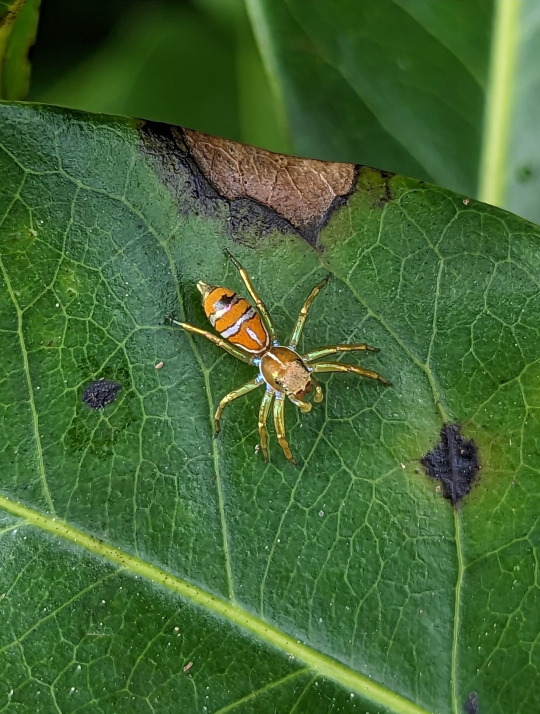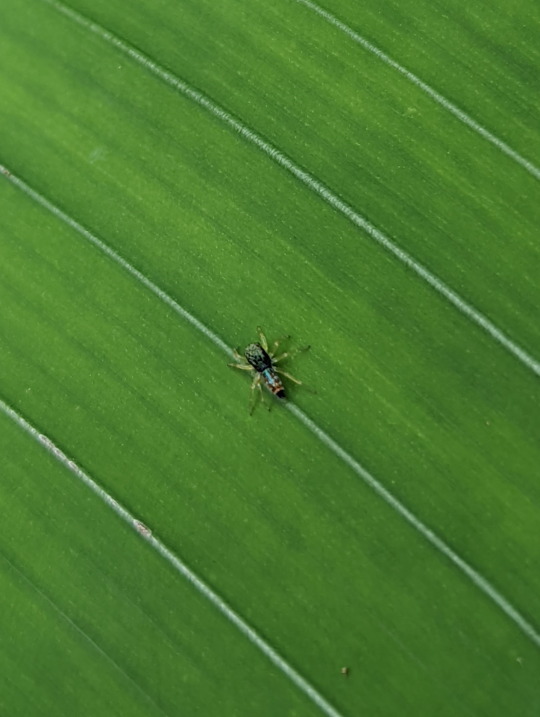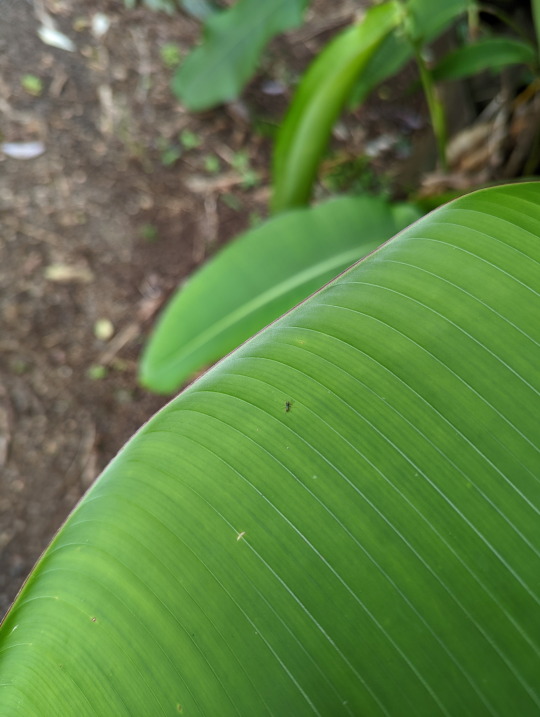#North-Queensland Jumping Spider
Explore tagged Tumblr posts
Text


10/09/21 - Photos 1-2 - C. baehrae


04/03/23 - Photos 3-4 - C. bitaeniata


24/11/23 - Photos 5-6 - C. thalassina


23/06/23 - Photos 7-8 - C. micarioides (different specimens)
So far, these are the four species of Cosmophasis I've come across. Lovely iridescent jumping spiders.
10/09/21-24/11/23 - Cosmophasis spp.
QLD:WET-BRB
#Cosmophasis#Cosmophasis baehrae#Baehr's Cosmophasis#Cosmophasis micarioides#North Queensland Jumping Spider#Cosmophasis thalassina#Sea-green Northern Jumper#Cosmophasis bitaeniata#Green Ant-hunter Spider#Jumping Spiders#Iridescent Jumping Spiders#Araneae#Spiders#Arachnida#Arachnids#Chelicerata#Chelicerates#arthropods#arthropoda#invertblr#invertebrates
206 notes
·
View notes
Text
@itsmyturnonthegender submitted: Can you id my leetol friend? From North Queensland, Australia




Just the cutest little thing I’ve ever seen
Wow…..incredibly tiny. Absolutely perfect. It’s a jumping spider but it’s too dang tiny to tell you which species! Not sure if it’s even an adult or a juvenile, and juveniles can sometimes be hard to ID. If anyone else recognizes the species, though, feel free to comment!
Update: An elegant fly mimic, Abracadabrella elegans.
163 notes
·
View notes
Text
TAFAKKUR: Part 126
Spider Silks: Part 2
Analysis of silk
The silk itself is a material identified as a “scleroprotein.” When created in the glands it is a fluid; only when dragged outside the body does it solidify into thread. Once it was believed that contact with air produced the toughening, but it currently looks that the drawing-out activity alone is accountable for the change.
To carry out the exertion done by the glands, a spider is armed with spinnerets, usually six in number. These are as accommodating as fingers; they can be prolonged, compacted, and overall be applied like human hands. In the “spinning field,” where the spinnerets are congregated, single threads are joined into numerous compound threads, and some of the dehydrated threads may be covered with a gluey substance. Thus, a completed thread may be thin or thick, dry or sticky. It may also have the look of a bead-trimmed necklace. For the last kind, the spider spins rather unhurriedly and, drawing out the gluey thread, lets it go with a jolt. The liquid thus is organized in beads spread out lengthwise across the completed line.
The strand known as the dragline may be understood as a spider's “life line” because it performs as a lifeguard in all kinds of situations. The dragline goes along with the spider, no matter where or how far it journeys, winding out from spinnerets at the back of the body. It forms a portion of the building of webs, it grips its tiny builder firmly in problematic places, and it helps in absconding from adversaries. When a spider is inactive in a web, the dragline enables a rapid descent and escape. It allows energetic chasing spiders to jump from buildings, cliffs, or any tall position with absolute security.
Benefits of spider silk to us
The silk of the silkworm could be very profitable and marketable. There are, however, challenges. One is the changing thickness of a spider’s strand; the other is that it doesn’t well endure the interweaving process. Housing and feeding large numbers of silkworms is not difficult. But housing and feeding large numbers of spiders? There are enormous difficulties.
Native inhabitants of New Guinea have used spider silk in a variety of conditions. They make fishing nets, traps, and such objects as bags, headdresses that will keep away rain, and caps. These are not formed from single threads but from tangled, warped threads. The aboriginals of North Queensland, Australia, look to spiders for their angling supplies.
Spider silk has been valuable to the manufacturers of such complex instruments as astronomical telescopes, guns, and engineers’ levels. The threads, being exceedingly fine but nonetheless robust, are outstanding for sighting marks. Throughout the Second World War, there was a significant demand for spider thread for surveying and laboratory instruments. Black widow spiders were utilized for the manufacture of this silk.
One drawback to the use of spider silk in industry is that it might slump in a moist environment. To overcome this problem, strands of platinum or etching on glass plates take its place in such instruments as periscopes and bombsights.
Spider’s silk also might have healing properties. Due to its antibacterial properties and because the silk is abundant in vitamin K, it may be efficient at clotting blood. Because of the problems in obtaining and handling extensive amounts of spider silk, the largest known piece of cloth made of spider silk is an 11 by 4-foot (3.4 by 1.2 m) fabric made in Madagascar in 2009. Eighty-two persons labored for a period of four years to gather over one million golden orb spiders and extract silk from them.
Applications of spider silk
As mentioned, human beings have been using spider silk for thousands of years.
The manufacture of contemporary synthetic super-fibers such as Kevlar (bulletproof material) includes petrochemicals, which adds to pollution. Kevlar is also strained from concentrated sulphuric acid. In comparison, the manufacture of spider silk is totally ecologically sustainable. It is created by spiders at ambient temperature and pressure and is strained from water. Furthermore, silk is totally biodegradable. If the manufacture of spider silk ever becomes industrially practical, it could be a substitute for Kevlar and be used to create a varied extent of articles such as: bulletproof vests, wear-resistant lightweight clothing, ropes, nets, seat belts, parachutes, rust-free boards on motor vehicles or boats, biodegradable bottles, bandages, surgical thread, artificial tendons or ligaments, and backings for weak blood vessels.
Synthetic spider silk
Duplicating the multifaceted settings needed to make threads that are similar to spider silk has been difficult to both research and manufacture. Through genetic engineering, Escherichia coli bacteria, yeasts, plants, silkworms, and animals have been utilized to produce spider silk proteins. Yet, these synthetic threads have diverse, simpler features than those of a spider. Manmade spider silks have lesser and unsophisticated proteins than natural dragline silk, and have subsequently half the diameter, strength, and flexibility.
One tactic is to remove the spider silk gene and utilize additional life forms to generate the spider silk. Canadian biotechnology company Nexia effectively produced spider silk protein in transgenic goats that passed the gene for it; the milk made by the goats comprised noteworthy amounts of the protein: 1-2 grams of silk proteins per liter of milk. To make spider silk, Nexia utilized damp whirling and pressed the silk protein across minor extrusion cavities in order to mimic the performance of the spinneret, but this process was not adequate to duplicate the sturdier characteristics of innate spider silk.
In March 2010, investigators from the Korea Advanced Institute of Science and Technology was able to produce spider silk by means of the bacteria E. coli, altered with definite genes of the spider Nephila clavipes. This tactic removes the necessity of milking spiders.
It should be noted that the manufacture of spider silk is not easy and there are intrinsic difficulties. First of all, spiders cannot be cultivated like silkworms since they are flesh-eaters and will merely eat each other if in proximity to each other. The silk produced is very slight, so 400 spiders would be required to make only one square yard of cloth. The other problem is, silk also toughens when subjected to air, which makes working with it problematic.
A different tactic is to study how spiders whirl silk and then replicate this process to make artificial spider silk. The silk itself would also have to be synthetically produced. Chemical production of spider silk is not feasible at present due to the absence of information about the makeup of silk. Randolph V. Lewis, Professor of Molecular Biology at the University of Wyoming in Laramie, has introduced silk genes into Escherichia coli bacteria so that the recurring sections of spidroin 1 and spidroin 2 efficaciously come to form. Others theorize about the likely gene introduction into fungi and soya plants. It may also be possible to modify the silk genes for precise intentions.
Why a spider’s house is the frailest of houses
Spider silk is stronger than steel, but the Qur’an (29:41) states that the flimsiest of houses is the spider’s house. The per unit weight of the dragline silk of the golden orb spider is one of the world’s hardest fibers. Webs are combinations of many kinds of spider silk, all able to be produced by the same spider. The web radials are strong, but the somewhat feebler circumferential (quasi-circular concentric) fibers are flexible and gluey to absorb the energy of a flying insect and hold it in place. The strongest of all is the fiber, which the spider uses for transport, the dragline silk. In summary, the spider fabricates both sturdy as well as feeble fibers and the web it weaves to catch flying insects is weaker; this may be the reason why it is referred to in the Qur’an as the “frailest” of houses.
Conclusions
Scientists are foreseeing many potential uses for biosilk. Textile usages are noticeable one. The flexibility and potency of prevailing merchandises such as spandex and nylon have to be improved. Since it is lightweight, hardy and flexible, biosilk may also have uses in satellites and aircraft. More prominently, the new group of progressive things that spider silk investigation may cause has the prospective to alter our lives in innumerable manners that we can barely imagine. More than 72 years have passed since the inventions of Wallace and Carothers that gave the world nylon that led us into the age of polymers. Artificial spider silk may help produce super-performing clothes of the future. Earthquake resistant suspension bridges hung from cables of synthetic spider silk fibers may someday be a reality.
#allah#god#muhammad#prohet#sunnah#hadith#quran#ayah#islam#revert#muslimah#hijab#help#convert#religion#muslim#reminder#dua#salah#pray#prayer#welcome to islam#how to convert to islam#new muslim#new revert#new convert#revert help#convert help#islam help
1 note
·
View note
Photo








BRIDGETTE
Over the past two years Bridgette has dedicated every spare minute to finding, photographing and identifying some of the worlds smallest animals. She is lucky to live near the Cairns Botanic Gardens where she spent countless hours in search of the many hidden treasures.
Bridgette started using her macro photography to capture images of the incredible variety of fungi in Tropical Far North Queensland. She quickly gained a following on her fungi dedicated Instagram account and produced a calendar called Phallic Fungi in 2020. The specialised imagery gained media attention and the calendar sold out.
In a brand-new enterprise not offered in Cairns previously, Bridgette is now running Guided Tours Let’s Go Buggin for those interested in seeing and or photographing some of the many of the lifeforms she has photographed in the Cairns Botanic Gardens. Her 1000 plus hours spent in the gardens has allowed her to become aware of many host plants and locations for a variety of caterpillars, cocoons, moths and butterflies, leaf, tree and planthoppers, praying mantis, jumping spiders, tortoise beetles, damselflies and dragonflies, and a variety of frogs.
During the Wet Season in Cairns (usually November to May), there are many beautiful and unusual fungi to be found and photographed, and Let’s Go Shroomin Weekly Tours run each Sunday.
To participate in a tour with Bridgette, please visit: https://aussiemacrophotos.com
0 notes
Photo





Cairns - Daintree National Park
March 27, 2017
Today we bussed North for a full day of activities! Starting with a hour and a half bus ride up to the Daintree rainforest. Once we arrived we had a brief introduction about the indigenous people as well as the rainforest itself. Fun Fact: The Daintree rainforest is the oldest rainforest in the world. Aging from 150 to 200 mullion years old, making that Amazon look like a baby at only around 50 million. Moving on! After this we went for a dip in the fresh water of the Mossman Gorge and did a short hike in the surrounding area. This was our only swim of the day as almost all other water sources in the area are infested with tons of crocodiles. Speaking of which, once we were done splashing around we made our way to the Daintree River where we jumped into a boat and went for a cruise to see some crocs! Unfortunately since the water was so warm they tend to not have to get out of the water to sunbath this time of year, therefore making it hard for us to get a good look. Luckily though we still got to see 2 babies (seriously so small and cute basking on the logs) and one 2 metre croc that actually had himself beached. Crazy to think of that was still a small one AND they aren’t the only killers in that river! The Daintree River is also home to 10,000 Bull Sharks. Long story short, keep your arms and legs in the boat at all times and for the love of god don’t go swimming. Side note: a week ago in Innisfail, Queensland a teenage boy jumped off a bridge to impress a backpacking girl showing her that locals don’t get eaten, sure enough within seconds a croc had his arm. Lucky for him it was a smaller one and he managed to gouge its eyes and escape only missing one arm. TRUE STORY! After this we went for some lunch on the beach which was actually kind of a tease since it looked so beautiful yet we all knew what was swimming around out there. Once we stuffed our faces we hopped back on the bus to go to the next hike and while driving we came across 2 wild Cassowary’s! Sadly we didn’t see any while on our hike, we just saw multiple massive Orb Weaver spiders, ate some ants that tasted like lemons (okay Britt did not me), and learned about more dangerous plants. To end our tour we enjoyed some homemade ice cream which we ate at a beautiful lookout. Lesson of this day tour was: There really is something that can kill you everywhere you go in Australia, but damn it’s interesting!
0 notes
Photo


Cosmophasis micarioides, “North-Queensland Jumping Spider”. Very small specimen.
27/04/22
#Cosmophasis micarioides#North-Queensland Jumping Spider#Cosmophasis#iridescent jumping spiders#jumping spiders#spiders#spiders tw#arachnophobia#typical spiders#Entelegyne spiders#Chelicerata#Chelicerates#Chrysillini#Arachnida#Araneae#Araneomorphae#Entelegynae#Salticoidea#Salticinae
6 notes
·
View notes